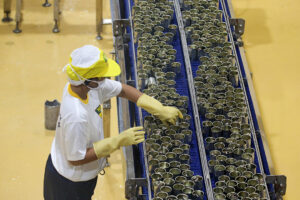




Philippines Trade Update: Exports momentum continues
 DOWNLOAD
DOWNLOAD

Quarterly Economic Growth Release: More BSP cuts to come
 DOWNLOAD
DOWNLOAD

Monthly Economic Update: Fed catches up
 DOWNLOAD
DOWNLOAD


September manufacturing output grows by 9.1%

Factory output rose in September — the fastest pace in 18 months — driven by sustained domestic demand and resilient exports, the Philippine Statistics Authority (PSA) reported on Thursday.
Preliminary results of the PSA’s latest Monthly Integrated Survey of Selected Industries (MISSI) showed factory output, as measured by the volume of production index (VoPI), expanded by 9.1% year on year in September from 4.5% a year ago and the revised 6.8% in August.
The September print was the fastest growth since 346% in March 2022.
“Several factors contributed to this robust expansion, including good domestic demand, resilient exports, and ongoing infrastructure projects,” Robert Dan J. Roces, senior assistant vice-president and chief economist at Security Bank Corp., said in an e-mail.
On a month-on-month seasonally adjusted basis, the manufacturing sector’s VoPI eased to 1.5% from the 2.7% growth in August.
Year to date, factory output averaged 5.7%, lower than 19.8% a year earlier.
“One of the biggest contributors to this improvement (in September) was the manufacturing of electrical equipment, the Philippines’ largest export. Supporting this was the fact that the [peso] was relatively weak against the US dollar in September, which helped make Philippine exports more competitive abroad,” HSBC economist for ASEAN Aris Dacanay said in an e-mail.
The local currency averaged PHP 56.79 in September, weaker than PHP 56.16 in August, according to Bangko Sentral ng Pilipinas (BSP) data.
“Despite elevated inflation and a weaker peso, businesses remained optimistic and continued to invest in production, fueling the industry’s growth momentum,” Mr. Roces said.
The PSA noted annual growth in eight out of 22 industry divisions in September, led by the manufacture of coke and refined petroleum products (78.6% from 47.5%); computer, electronic and optical products (2.9% from -5.1%); and basic metals (14% from 5.6%).
Also recording faster annual increases in September were electrical equipment (26.5% from 20.7%) and printing and reproduction of recorded media (17.6% from 5.7%).
Several industry divisions recorded slower annual growth such as transport and equipment (11% from 16.2%); beverages (8% from 9.5%); basic pharmaceutical products and pharmaceutical preparations (0.5% from 8%);
Meanwhile, 14 industry divisions recorded annual declines in September, led by wearing apparel (-35.8% from -16.5%); fabricated metal products, except machinery and equipment (-26.5% from -11.2%); leather and related products, including footwear (-15.1% from -6.3%), and food products (-8.3% from -1%).
Average capacity utilization — the extent to which industry resources are used in producing goods — averaged 74.3% in September, up from 71.7% a year ago and 74% in August.
The PSA said all 22 sectors recorded an average capacity utilization rate of at least 50% for the month.
Philippine Exporters Confederation, Inc. (Philexport) President Sergio R. Ortiz-Luis, Jr., said easing inflation might have helped boost manufacturing output.
He expects the uptrend in the manufacturing sector to continue amid improvements in the supply chain and employment. — Mariedel Irish U. Catilogo
This article originally appeared on bworldonline.com





 By BusinessWorld
By BusinessWorld